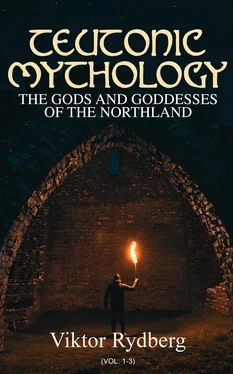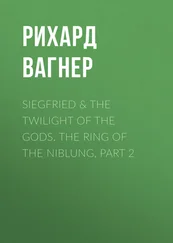Viktor Rydberg - Teutonic Mythology - The Gods and Goddesses of the Northland (Vol. 1-3)
Здесь есть возможность читать онлайн «Viktor Rydberg - Teutonic Mythology - The Gods and Goddesses of the Northland (Vol. 1-3)» — ознакомительный отрывок электронной книги совершенно бесплатно, а после прочтения отрывка купить полную версию. В некоторых случаях можно слушать аудио, скачать через торрент в формате fb2 и присутствует краткое содержание. Жанр: unrecognised, на английском языке. Описание произведения, (предисловие) а так же отзывы посетителей доступны на портале библиотеки ЛибКат.
- Название:Teutonic Mythology: The Gods and Goddesses of the Northland (Vol. 1-3)
- Автор:
- Жанр:
- Год:неизвестен
- ISBN:нет данных
- Рейтинг книги:4 / 5. Голосов: 1
-
Избранное:Добавить в избранное
- Отзывы:
-
Ваша оценка:
- 80
- 1
- 2
- 3
- 4
- 5
Teutonic Mythology: The Gods and Goddesses of the Northland (Vol. 1-3): краткое содержание, описание и аннотация
Предлагаем к чтению аннотацию, описание, краткое содержание или предисловие (зависит от того, что написал сам автор книги «Teutonic Mythology: The Gods and Goddesses of the Northland (Vol. 1-3)»). Если вы не нашли необходимую информацию о книге — напишите в комментариях, мы постараемся отыскать её.
One of Rydberg's mythological theories developed in this book is that of a vast World Mill which rotates the heavens, which he believed was an integral part of Old Norse mythic cosmology.
Teutonic Mythology: The Gods and Goddesses of the Northland (Vol. 1-3) — читать онлайн ознакомительный отрывок
Ниже представлен текст книги, разбитый по страницам. Система сохранения места последней прочитанной страницы, позволяет с удобством читать онлайн бесплатно книгу «Teutonic Mythology: The Gods and Goddesses of the Northland (Vol. 1-3)», без необходимости каждый раз заново искать на чём Вы остановились. Поставьте закладку, и сможете в любой момент перейти на страницу, на которой закончили чтение.
Интервал:
Закладка:
Even this question can be answered, thanks to the mythic fragments preserved. A feature common to all well-developed mythological systems is the view that the human race in its infancy was under the special protection of friendly divinities, and received from them the doctrines, arts, and trades without which all culture is impossible. The same view is strongly developed among the Teutons. Anglo-Saxon documents have rescued the story telling how Ask's and Embla's descendants received the first blessings of culture from the benign gods. The story has come to us through Christian hands, which, however, have allowed enough of the original to remain to show that its main purpose was to tell us how the great gifts of culture came to the human race. The saga names the land where this took place. The country was the most southern part of the Scandinavian peninsula, and especially the part of it bordering on the western sea. Had these statements come to us only from northern sources, there would be good reason for doubting their originality and general application to the Teutonic tribes. The Icelandic-Norwegian middle-age literature abounds in evidence of a disposition to locate the events of a myth and the exploits of mythic persons in the author's own land and town. But in this instance there is no room for the suspicion that patriotism has given to the southern-most part of the Scandinavian peninsula a so conspicuous prominence in the earliest history of the myth. The chief evidence is found in the traditions of the Saxons in England, and this gives us the best clue to the unanimity with which the sagas of the Teutonic continent, from a time prior to the birth of Christ far down in the middle ages, point out the great peninsula in the northern sea as the land of the oldest ancestors, in conflict with the scholastic opinion in regard to an emigration from Troy. The region where the myth located the first dawn of human culture was certainly also the place which was regarded as the cradle and centre of the race.
The non-Scandinavian sources in question are: Beowulf's poem, Ethelwerdus, Willielmus Malmesburiensis, Simeon Dunelmensis, and Matthæus Monasteriensis. A closer examination of them reveals the fact that they have their information from three different sources, which again have a common origin in a heathen myth. If we bring together what they have preserved of the story we get the following result: [8]
One day it came to pass that a ship was seen sailing near the coast of Scedeland or Scani, [9]and it approached the land without being propelled either by oars or sails. The ship came to the sea-beach, and there was seen lying in it a little boy, who was sleeping with his head on a sheaf of grain, surrounded by treasures and tools, by glaives and coats of mail. The boat itself was steady and beautifully decorated. Who he was and whence he came nobody had any idea, but the little boy was received as if he had been a kinsman, and he received the most constant and tender care. As he came with a sheaf of grain to their country the people called him Scef, Sceaf. [10](The Beowulf poem calls him Scyld, son of Sceaf, and gives Scyld the son Beowulf, which originally was another name of Scyld.) Scef grew up among this people, became their benefactor and king, and ruled most honourably for many years. He died far advanced in age. In accordance with his own directions, his body was borne down to the strand where he had landed as a child. There in a little harbour lay the same boat in which he had come. Glittering from hoar-frost and ice, and eager to return to the sea, the boat was waiting to receive the dead king, and around him the grateful and sorrowing people laid no fewer treasures than those with which Scef had come. And when all was finished the boat went out upon the sea, and no one knows where it landed. He left a son Scyld (according to the Beowulf poem, Beowulf son of Scyld), who ruled after him. Grandson of the boy who came with the sheaf was Healfdene—Halfdan, king of the Danes (that is, according to the Beowulf poem).
The myth gives the oldest Teutonic patriarchs a very long life, in the same manner as the Bible in the case of Adam and his descendants. They lived for centuries (see below). The story could therefore make the culture introduced by Scef spread far and wide during his own reign, and it could make his realm increase with the culture. According to scattered statements traceable to the Scef-saga, Denmark, Angeln, and at least the northern part of Saxland, have been populated by people who obeyed his sceptre. In the North Götaland and Svealand were subject to him.
The proof of this, so far as Denmark is concerned, is that, according to the Beowulf poem, its first royal family was descended from Scef through his son Scyld (Skjold). In accordance herewith, Danish and Icelandic genealogies make Skjold the progenitor of the first dynasty in Denmark, and also make him the ruler of the land to which his father came, that is, Skane. His origin as a divinely-born patriarch, as a hero receiving divine worship, and as the ruler of the original Teutonic country, appears also in Fornmannasögur , v. 239, where he is styled Skáninga god , the god of the Scanians.
Matthæus Westmonast. informs us that Scef ruled in Angeln.
According to the Anglo-Saxon chronicle, the dynasty of Wessex came from Saxland, and its progenitor was Scef.
If we examine the northern sources we discover that the Scef myth still may be found in passages which have been unnoticed, and that the tribes of the far North saw in the boy who came with the sheaf and the tools the divine progenitor of their celebrated dynasty in Upsala. This can be found in spite of the younger saga-geological layer which the hypothesis of Odin's and his Trojan Asas' immigration has spread over it since the introduction of Christianity. Scef's personality comes to the surface, we shall see, as Skefill and Skelfir.
In the Fornalder-sagas, ii. 9, and in Flateyarbók, i. 24, Skelfir is mentioned as family patriarch and as Skjold's father, the progenitor of the Skjoldungs. There can, therefore, be no doubt that Scef, Scyld's father, and through him the progenitor of the Skjoldungs, originally is the same as Skelfir, Skjold's father, and progenitor of the Skjoldungs in these Icelandic works.
But he is not only the progenitor of the Skjoldungs, but also of the Ynglings. The genealogy beginning with him is called in the Flateryarbók, Skilfinga ætt edr skjoldunga ætt . The Younger Edda also (i. 522) knows Skelfir, and says he was a famous king whose genealogy er köllut skilvinga ætt . Now the Skilfing race in the oldest sources is precisely the same as the Yngling race both from an Anglo-Saxon and from a heathen Norse standpoint. The Beowulf poem calls the Swedish kings scilfingas , and according to Thjodulf, a kinsman of the Ynglings and a kinsman of the Skilfing, Skilfinga nidr , are identical (Ynglingatal, 30). Even the Younger Edda seems to be aware of this. It says in the passage quoted above that the Skilfing race er i Austrvegum . In the Thjodulf strophes Austrvegar means simply Svealand, and Austrkonungur means Swedish king.
Thus it follows that the Scef who is identical with Skelfir was in the heathen saga of the North the common progenitor of the Ynglinga and of the Skjoldunga race. From his dignity as original patriarch of the royal families of Sweden, Denmark, Angeln, Saxland, and England, he was displaced by the scholastic fiction of the middle ages concerning the immigration of Trojan Asiatics under the leadership of Odin, who as the leader of the immigration also had to be the progenitor of the most distinguished families of the immigrants. This view seems first to have been established in England after this country had been converted to Christianity and conquered by the Trojan immigration hypothesis. Wodan is there placed at the head of the royal genealogies of the chronicles, excepting in Wessex, where Scef is allowed to retain his old position, and where Odin must content himself with a secondary place in the genealogy. But in the Beowulf poem Scef still retains his dignity as ancient patriarch of the kings of Denmark.
Читать дальшеИнтервал:
Закладка:
Похожие книги на «Teutonic Mythology: The Gods and Goddesses of the Northland (Vol. 1-3)»
Представляем Вашему вниманию похожие книги на «Teutonic Mythology: The Gods and Goddesses of the Northland (Vol. 1-3)» списком для выбора. Мы отобрали схожую по названию и смыслу литературу в надежде предоставить читателям больше вариантов отыскать новые, интересные, ещё непрочитанные произведения.
Обсуждение, отзывы о книге «Teutonic Mythology: The Gods and Goddesses of the Northland (Vol. 1-3)» и просто собственные мнения читателей. Оставьте ваши комментарии, напишите, что Вы думаете о произведении, его смысле или главных героях. Укажите что конкретно понравилось, а что нет, и почему Вы так считаете.











